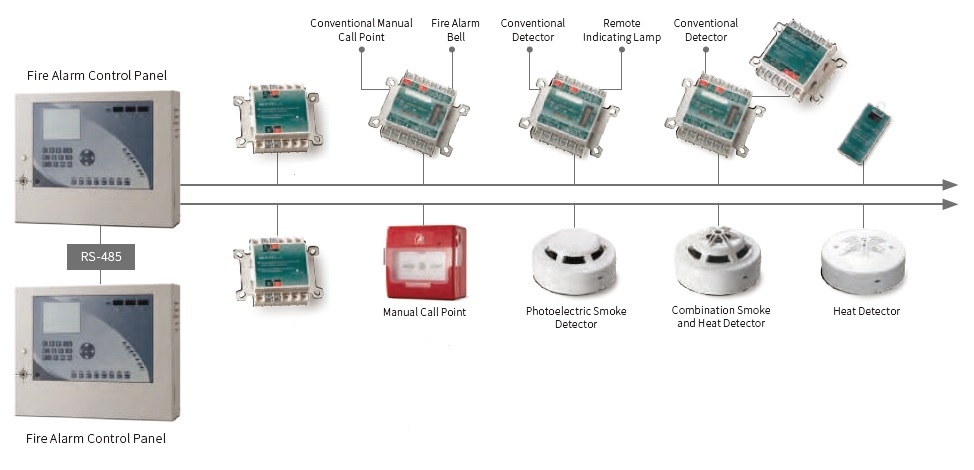What is Fire Alarm System & Its Main Device Parts Comparison

In general, fire alarm system can be categorized into the following:
- Automatic or manual
- Conventional or addressable
- Wired or wireless
- Distributed/decentralized or centralized
- Open or closed protocols
The main components of a fire alarm system include:
Fire Alarm Control Panel (FACP) / Fire Alarm Control Unit (FACU)
This panel is also known as the brain of the system. It identifies incoming and outgoing signal, interprets, and then determines the corresponding action automatically. It connects all the accessory parts such as smoke detector, relay interface, notification appliance, transmitter, etc.
It is mainly broken down into conventional analog or addressable digital types. The conventional alarm systems uses a single circuit for each zone, so it cannot pinpoint the exact device triggered in the case of a fire.
On the other hand, addressable panels only need one signaling line circuit (SLC) or loop, because each addressable accessory device can digitally sends signal for exact pinpoint of the device triggered.
In general, conventional types are more suitable for smaller construction commissioning projects, while addressable types are ideal for larger commercial buildings.
Manual Call Point (MCP) / Pull Station
In the US, it is structured as a device with manual lever for triggering the alarm. While in Europe, the device is shaped like a button. It is always painted in red color to distinguish it for fire alert.
Power Supply
This is the battery that powers the control panel. When there is power outage, the battery will be activated to assist in continuing the alarm system operation for about a day typically. Some other types of battery backup power supply can also work for up to 72 hours.
Cables & Wires
To connect all the devices together, the fire cables used must be fire-resistant, in either standard or enhanced materials.
Detector Alarm
These are sensors that are typically placed on the ceilings for detection of various elements. Most common types are smoke and heat detection. They can sense smoke in different stages of fire via different methods.
Some common types include:
- Optical detection – Utilizing infrared light to sense the amount of smoke presence in the device chamber.
- Beam detection – Using transmitter and receiver devices to sense smoke and its reflection.
- Ionization – Using ionizing particles in the device chamber to detect the current flow.
- Aspirating detection – sample the atmosphere for smoke particle presence
Input/Output Module Interface
Relay devices for connecting external devices such as vent duct, fans, sprinkler, door closer, intercom system, etc. Once the fire alarm panel sends message to module interface for subsequent action, it will activate appropriate response to prepare the building to control or alert occupants about the fire.
Notification Appliance Alarm / Siren
An audible alarm is used for warning occupants inside of fire presence. Common types include:
- Electronic sounder
- Visual strobe
- Combination siren and strobe
- Public address voice alarm
In conclusion, many elements are required for a fire alarm system to work properly. There is no best alarm system, but there will be one that is most suitable for your use. For any projects or inquiry, please contact our specialists for more information.

